Flagstaff Observing – Dec. 10 & 11, 2004
I met Bill Ferris and Max Oeschlaeger once again, in the lower parking lot at the US Naval Observatory to take advantage of some calm, dark skies this past Friday. Bill’s 18″ Obsession was already set up, and Max had his recliner lawn chair set up for binocular observing. I managed to set up this time without taking notches out of my hands, which really got things off to a great start. My plan for this evening was to get some wide field piggyback shots. Knowing that focusing is a real booger, I tried doing a twilight auto-focus on some distant tree-tops. It seemed to lock on, so I carefully set the camera down with endless mental notes not to touch or look too strongly at the lens. My next step was spending some quality time with the polar alignment.
With the scope lined up and the camera focused, I shut myself in the car and put on thermals, layered clothes, and so on for maximum cold comfort. Meanwhile I could hear Bill and Max discussing some doubles they were picking off while the sky still darkened. Finally, ever so carefully, I screwed the camera onto the top of the scope, did a preliminary balance, and waited for full dark while talking with Bill and Max. I asked if they had any plans to check out Comet Machholz and we figured it wouldn’t be long before we had a chance to see it.
Before long, the sky was a blue-black foam of stars, and I started to line up on Cassiopeia. I’ve been wanting a wide field shot of that constellation. I’ve wondered how well some of its open clusters would show up. Of course, as always happens when I switch from a horizontally balanced position to anything roughly skyward, the balance goes out the window. So I had to do some more weight shifting, before everything seemed good. I then took my first 2 minute exposure, and found that my focus was no good. So either I breathed on the focusing ring, or locking in on a tree at 100 yards isn’t close enough to infinity. Several test shots, and about twenty minutes later, I chanced upon a decent focus. I also stopped down the aperture from f/5.3 to f/11 so it would be a little more forgiving.
And away I went for the first good exposure. So you know what happened next, right? Yeah. Star trails. I checked and the RA clutch was loose. Weird. So I tightened it and made another shot. More star trails. After some fumbling around, it turned out the scope was wedging against the SW tripod leg. I don’t know about anybody else who just toys with astrophotography, but all this whittling away of good observing time really bugs me. I think that’s why I’ve gravitated so much more toward sketching than I thought I would. Oy. It was awesome having Bill and Max there, because I could get some beautiful views through the Obsession, and Max’s image-stabilizing binoculars during the exposures.
Anyway, I decided to leave Cassiopeia for another time, and went instead for some shots of the Pleiades and Hyades together in the same frame. The polar alignment was on target enough that I was getting really stable 11 minute exposures…which is good since I had stopped down the aperture. Here is the result after dark frame, stacking and flat field work in Photoshop.
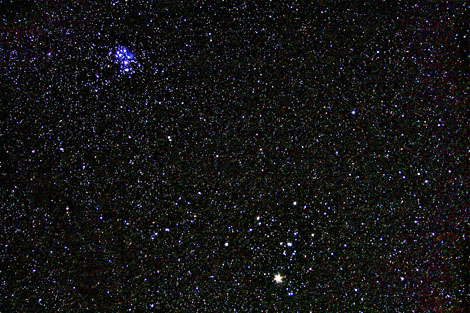
Large Image (450K)
During this time, Bill had been pulling up galaxies, planetary nebulae, and open clusters that unfolded in exquisite detail. I don’t think I can express enough what a treat it is to see these things in the 18″ scope. I’m very grateful.
Before heading over to the observatory, I got coordinates for Machholz from the Comet Ephemerides site. A quick check in the Bright Star Atlas showed that it would be conveniently bracketed in an area pointed to by a set of stars in Lepus. After doing some widefield photography of the Pleiades and Hyades, and mooching cool views off Bill’s scope, Lepus had risen to a good height in the south. After just a few seconds of circling around the target area with the binoculars, it popped right into view. It was bright, large and easily visible in the cheap 10 X 50s. After taking the binoculars away, I could also see it naked eye. Funny how that works. Limiting magnitude was very good at the site, and we were able to just make out M33 naked eye. But Machholz was obvious enough I don’t think the sky needed to be that dark.
Bill kindly slewed the Obsession over, and wow, what a sight. The cool soft glow filled the eyepiece (whose field of view I don’t recall). There appeared to be a wide short tail flowing to the left, while averted vision gradually showed a very thin ion tail shooting off the bottom of the view. The nucleus was a thick, kernel of a dot.
Machholz was large and bright enough that I figured it might show up in a series of piggyback shots of the area. Over the course of an hour and ten minutes, I grabbed seven 10-minute exposures. The interesting thing I hadn’t thought much about is that comet photography requires you to stack your images based on the comet nucleus, not the background stars, because of the rapid motion against the background. Here is the stacked photo:
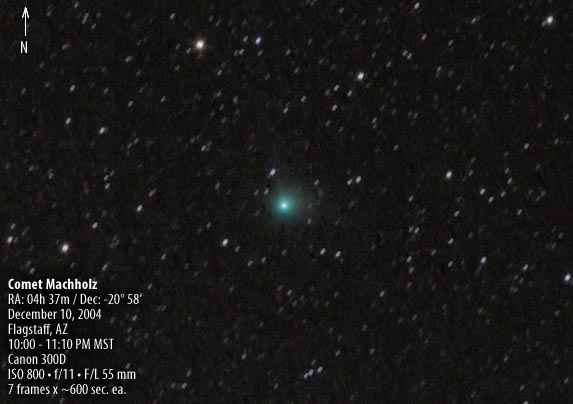
To see if I could pick up the faint tails we saw in the 18″ scope, I boosted contrast in the stacked image. It looks ugly, but I think it does show shape better:
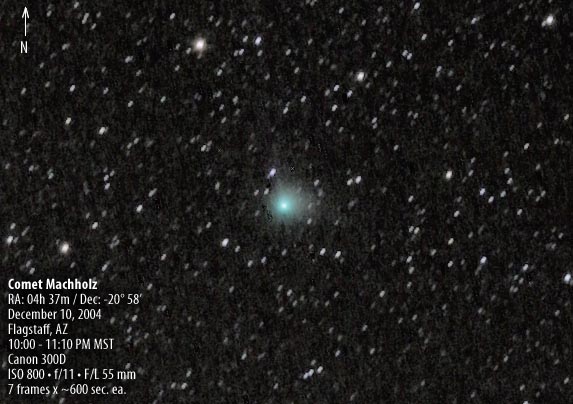
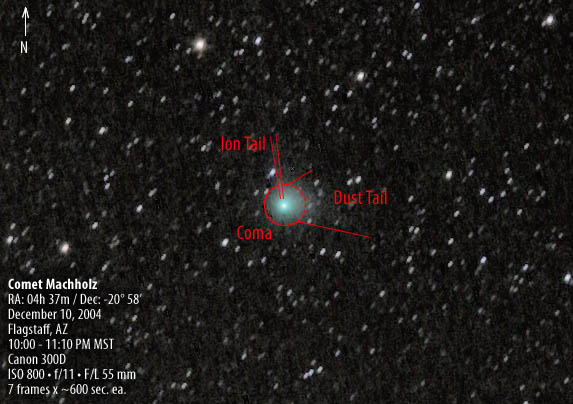
Just for kicks, I made a very short animation from the 7 frames.
Film (280K, .mov format)
While taking those shots of Machholz and a wide field of Orion, I witnessed a few more spectacles in Bill’s scope. One was a look at M35 and NGC 2158. The depth of the view with M35 bright and widely spaced in the foreground, while NGC 2158 glowed softly far behind it was a new experience for me. But the best was to come, as Orion’s sword finally made its way from behind a nearby tree.
I have had my jaw drop looking at M42 from my own scope…but the view through the Obsession was so much more than I expected. The depth and brilliance of its swirling clouds, was beyond photographic. A photograph, no matter how colorful and crisp can not convey the glowing dimension of it. It gave the feel of a massive storm cloud with lightning piercing its mottled heart. The dark band of cloud swooping in front of the backdrop of glowing nebula was exactly that: a foreground cloud. There was no mistaking it for a dark gap between two glowing sections. I am still in awe thinking about it. And color…oh yes there was color. A soft but distinct aqua green glowing in the interior, with deeper gray along the gilded edges of the sweeping wings of the nebula. And along the sharp, linear southern edge of the trapezium pocket a slim ribbon of salmon pink. That was the first time I had seen color besides green in a DSO. If it weren’t for other photographic agendas, and the fact that I wasn’t the only person interested in getting a look, I could’ve hogged the eyepiece and bathed my eyes in that beautiful sight all night long.
After a little while, Bill zoomed in on the trapezium and we hunted for the faintest stars we could see. The E and F stars were a cinch, and then we made out another 6 stars in the vicinity. I really need a good dim-star reference, because I have no idea what their designations or magnitudes are. But they did match up to stars in some online photographs. After some checking, it looks like we didn’t catch wind of the G or H stars in that hunt.
Here are the stars I managed to pick out….
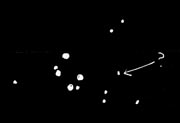
After some musing about whether the Horsehead Nebula might be visible, and some more imaging, Bill whirred his scope to the right region and invited us for a look. Under the filtering of a Hydrogen Beta filter, the IC 434 nebula swept faintly across the view, and right in the middle the rather large notch of B33 softly punched downward into the nebula. With a little time looking at it, I could make out a swirl of nebula sweeping around into the notch from the right. I’d been burning my eyes out checking LCD images on my camera every ten minutes, so I didn’t make out much more shape than that. But I considered it a great privilege to have seen this marvel in the sky. Bill also swapped in the UHC and OIII filters, as well as a non-filtered view. The UHC brought the nebula and notch out pretty well too–not as well as the HB filter, but still good. The OIII filter, as expected, knocked everything out of view. What was neat was that the naked eye view showed a very faint blur of the nebula, with an ever-so-slight darkening in the middle of it. So there it was, even in that view. Bill was kind enough to describe two brackets of stars that one can use to estimate the position where B33 should appear. Nice method. I recognize that asterism in photographs now. We finished that region with a look at the flame nebula. It was subtle, but fantastically structured.
As the final photographs of Orion started to pop up, I was happy to see that both the flame and horsehead nebulae were showing up ever so faintly in the widefield images.
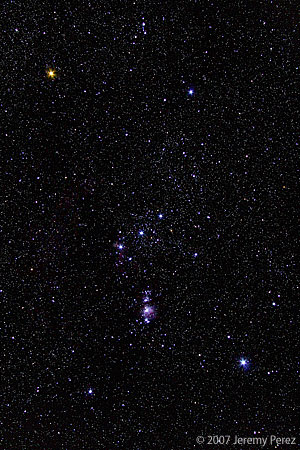
Click image for large version.
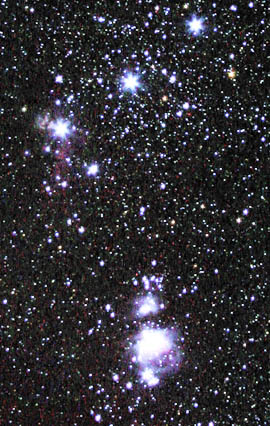
The next night (December 11th), I set up outside my front door. It was then that I came to the realization that December is a tough time for early evening observing. I had no idea that several blocks worth of Christmas lights would blow the sky out so bad. I even had trouble making out a couple stars in Ursa Minor, and the Milky Way was non-existant. So I set up the scope, and went inside to work on the previous night’s images. By 9 PM, the lights were out, and the sky was decent.
I would say limiting magnitude was 6.4 at the Naval Observatory, compared to 4.4 at my home when I started looking. Machholz had moved quite a bit further north, but was still simple to find with binoculars. I swung the scope over (6″ f/8 reflector), and started with a 37X view. The nucleus was a thick dot that didn’t survive direct vision, but was very obvious with slightly averted vision. The coma was sharper along the southeast side, lending the impression of a wide, short tail breezing off to the northwest. I couldn’t make out the thin ion tail like the night before. It surely benefits from aperture for that, but maybe given another month of brightening, that will show up in a smaller scope. It exhibited a decidedly greenish color, especially in comparison to the white background stars. The color was still there when I observed at 120X.
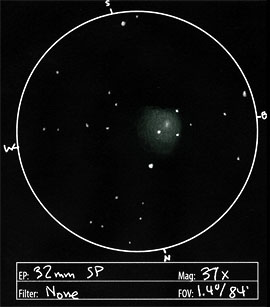
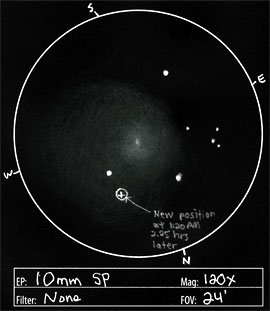
Next I went to M42 for my first try at sketching it. I made a point to keep my eyepieces in my pockets until using them, but they wanted to fog up like nobody’s business. So the sketching took a while. At 120X, the E and F stars were intermittently visible–which was pretty cool. I’ve had to go to 240X to see them before. One thing I noticed is that the dark nebula intruding on the trapezium looks like a hand reaching into a bright square pocket for the brilliant stars inside. The overall shape of the nebula suggests a bird at first glance, but the way the outer lines draw back actually reminds me more of: A) A Shadow Vessel from Babylon 5, B) a face hugger from Alien, and C) a brine shrimp. Man, that’s not flattering for such a beautiful nebula. But it’s hard to get rid of a lifetime worth of subliminal mental baggage :D. The brightest regions showed up as a minty green. Not the kind of widespread color like the night before in Bill’s scope, but still a nice sight.
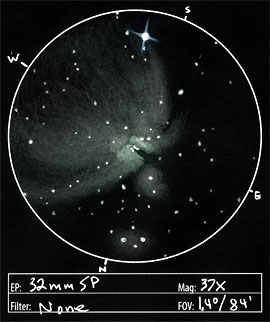
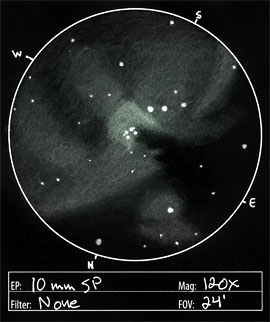
Before heading in, I grabbed one last look at Machholz to mark how far it had moved after a couple hours. Over the span of 2 hours and 15 minutes, it had moved noticeably north-northwest. Based on my 10 mm eyepiece FOV of 24′, I’d roughly estimate it moved 5′ in the span of 2.25 hours. So that works out to 2.2″ per minute at this point in its orbit. I know that’s pretty measley compared to the motion of the moon, but it still seems pretty cool to me to see that kind of motion across the star field.
Here’s hoping to see some more great things from this comet in the weeks to come.
After that, I grabbed all my frosty, icy gear and hauled it inside. I’m looking forward to sketching M42 at some more magnifications, and under the Ultrablock filter to capture all the different facets that amazing cloud holds.
Jeremy